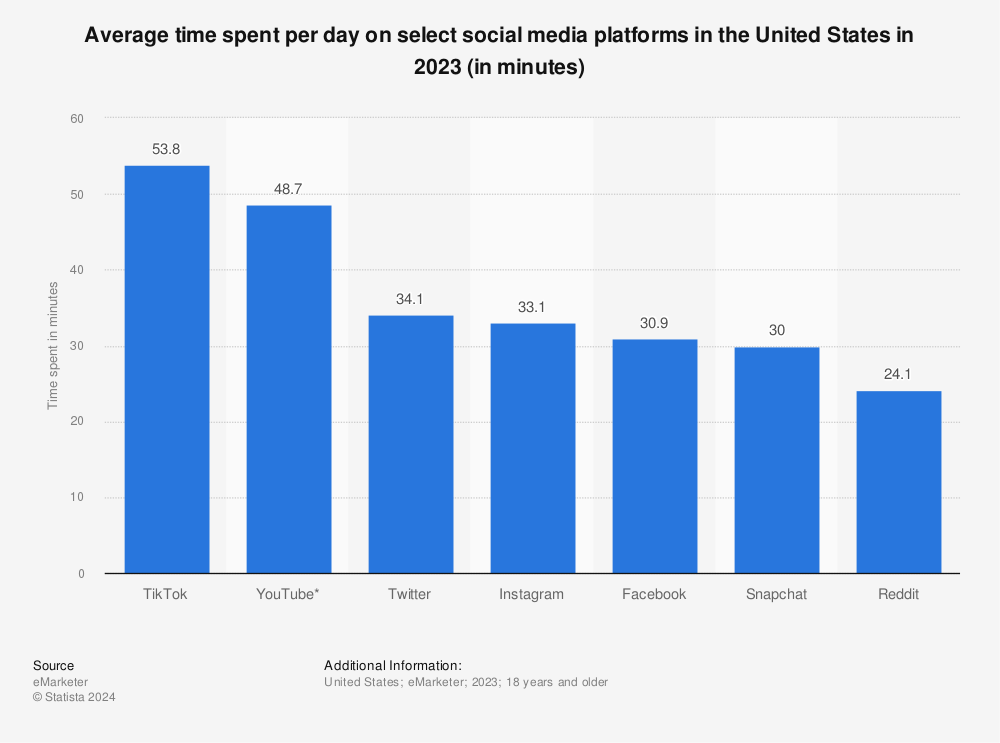With 5.17 billion people worldwide using social media, it's understandable that businesses have turned to social media as a marketing tool. Today, your business can engage directly with customers to uncover valuable insights about them, handle complaints, and develop a stronger value proposition by putting the customer at the heart of everything you do.
However, managing social media can be a daunting task without the right strategy and tools.
Social media management touches on a number of important elements, all of which form part of a well-structured digital marketing strategy. In this guide below, we'll connect the dots between social media strategy and social media management.
You'll also learn the most important factor of running a well-oiled social media management operation. Let's dive right in.
What is Social Media Management:
- What Is Social Media Management?
- Evolution of Social Media Management
- Roles and Responsibilities of a Social Media Manager
- Importance of Effective Social Media Management for Aspiring Social Media Managers
- How to Get Started With Social Media Management?
- Best Practices for Social Media Management
- Conclusion
What Is Social Media Management?
Simply put, it's the process of managing a complete social media strategy. But social media management is a little more strategic. It involves more than just replying to tweets and comments.
Erik Qualman, the author of Socialnomics, says,
"We don't have a choice on whether we do social media; the question is, how well we do it."
That's exactly what social media encompasses; the doing part of social media. It starts with creating a social media strategy, implementing it, and then managing the day-to-day activities on various social media platforms.
Beth Comstock, Vice-Chair of GE, puts it quite well,
"Marketing's job is never done. It's about perpetual motion. We must continue to innovate every day."
With this in mind, if we look at social media management on a more minute scale, it involves a continuous process of creating, publishing, analyzing, and engaging with content on social media platforms. It could be something as simple as replying to a follower's comment or as complex as creating a full-blown social media campaign.
Besides social media channels, this process also entails other verticals, such as:
- Online reputation management
- Paid social media advertising
- Social media analytics
- Community management
- Social listening and monitoring
Evolution of Social Media Management
Many years ago, when social media originated, its management wasn't as complex as it is today. Back in the day, brands could create a social media page and add content occasionally, and that would suffice.
However, as social media usage increased, so did the number of channels and their conventions.
Take Victoria's Secret as an example. The brand has been on social media for years.
Initially, Victoria's Secret only had a Facebook and an Instagram page. Both channels worked well for them, with the former having 29 million followers and the latter 76 million.
The brand mainly posted about its promotions, new products, sales, or celebrity endorsements. Victoria's Secret’s content was aesthetically pleasing, with models donning lingerie and a few videos of the annual fashion show.
Fast forward to today, Victoria's Secret has a presence on more platforms, such as TikTok. The kind of content the company posts has also evolved over time.
@victoriassecret
Now, it's common to see influencer campaigns and user-generated content on the brand's social media pages. Victoria's Secret has also added a link to its shop on Instagram and other platforms to capitalize on social commerce.
@victoriassecret See you in the front row, @Brittany Xavier. #VSFestivalSeason #FestivalOutfit ♬ Saturn X Slow Dancing In The Dark - reavesaudios
Besides the content type and availability of platforms, social media has also changed in terms of analytics. Now, marketers have more data to work with.
AI predictive analysis tools and social listening software are also available to find the tiniest insights previously overlooked. Similarly, personalization has found its place in social media marketing.
Instead of creating the same content for everyone, brands now cater to separate audience segments to keep everyone engaged. There was a time when Victoria's Secret was only thought to be for a certain body type.
However, now, the company celebrates body positivity and diversity, thanks to the insights gathered from social media. For example, a Mother's Day campaign run by Victoria's Secret on TikTok and Instagram showed the company's inclusivity for "mom bods."
@victoriassecret From a growing belly to their newborn bubble all new moms want (and deserve) to be comfy. #VSMothersDay #MothersDay #Gift ♬ This Will Be - audios4you
As social media evolves, so should brands. That's the only way to remain abreast of the competition and cater to changing consumer demands.
Roles and Responsibilities of a Social Media Manager
According to Indeed data, social media managers in the US make $57,463 per month. While this is the average, the salary can go up to $93,553 on the higher end and $35,295 on the lower end.

Social media manager salary in the US
So, what does a social media manager do to earn this amount of money? Let's look at some of the key roles and responsibilities.
- Social media strategy creation and execution: It includes creating a strategy, selecting the channels to use, and executing the plan. Some tasks may involve creating a content calendar, managing budgets for paid ads, etc.
- Social media platform management: It involves creating content, publishing posts, running campaigns, responding to comments, and partnering with influencers.
- Social media analytics: The manager analyzes social media metrics and provides insights on how to improve engagement and drive more traffic.
- Competitive analysis: Knowing what the competitors are doing is instrumental to a brand's success on social media.
- Audience engagement: It includes responding to comments and messages or hosting giveaways.
Indeed, data further shows that the top skill for social media management is social listening. An understanding of media buying can increase salary prospects by 40.09%, indicating the importance of social commerce.

Skills for social media management
It’s important for your social media manager to have most, if not all, of these skills. Otherwise, as Stuart Davidson says,
‘’If you think it’s expensive to hire a social media professional, just wait until you hire an amateur.’’
Importance of Effective Social Media Management for Aspiring Social Media Managers
Social media management is important for every business, irrespective of size and industry. Here's why.
Brand Awareness
According to Statista, brands spend $296 billion on social media ad spend worldwide. Why?
It helps them get their brand in front of a larger audience, leading to increased brand awareness. The importance of social media in brand awareness and reach is such that social media ads now account for 28.8% of all global digital advertising spending.
HubSpot data shows that more and more customers prefer to find new products through social media. Nearly 45% of millennials, 39% of GenZ, and 31% of Gen X like to use social media to find new products and services.
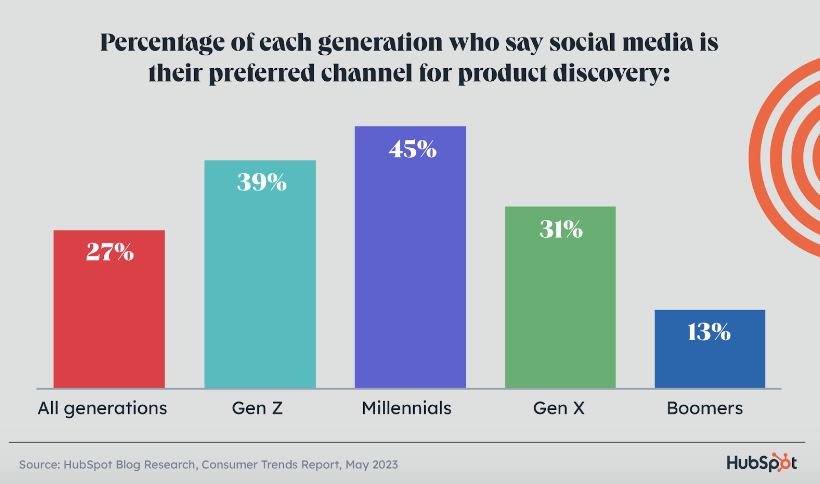
Percentage of people who prefer social media for product discovery
Customer Engagement
Social media allows businesses to directly engage with their customers, creating a more personal connection. Responding to comments and messages helps build a loyal customer base.
It also shows customers that brands don't merely consider them business entities, but actual human beings. Susan Cooper, Social Media Strategist at BuzzEdition, explains,
‘’Engage, Enlighten, Encourage and especially…just be yourself! Social media is a community effort, everyone is an asset.’’
Kosas does a great job of using these assets to its advantage.
The brand doesn't take a generic approach of leaving emojis or simple "thank you" comments. Instead, they take the time to write thoughtful responses.
Customer Service
Social media is no longer just for social engagement; it is also a medium for customer support. Brands that have a dedicated social media management team can respond to queries and solve problems through comments and DMs.
It's much quicker and also shows other people that the brand takes customer service seriously.
Again, Kosas is a good example here. In this post, one of the commenters wanted to know when the brand's new foundation will be back in stock. Kosas was prompt in its reply, providing an estimated timeline.
User-Generated Content (UGC) Collection
Effective social media management also helps brands collect user-generated content. The content can then be reused on the same platforms or in specific campaigns.
UGC not only provides content but also acts as social proof. It shows your potential customers that other people loved your product and were willing to share their experience.
Since Kosas seems to be acing its social media management, the brand's example fits here, too. The beauty company uses UGC to show its products in action and on different skin types.
Revenue Generation
At the end of the day, the crux of any company operation is to make money. Proper social media management facilitates this process.
Be it through customer service, increased brand awareness, social ads, or influencer collaborations, social media can bring more customers to your brand.
A HubSpot study found that 29% of marketers generate the highest return on investment (ROI) from Facebook. Instagram also ties in with Facebook, while YouTube takes third place, with 26% of marketers reporting high ROI.
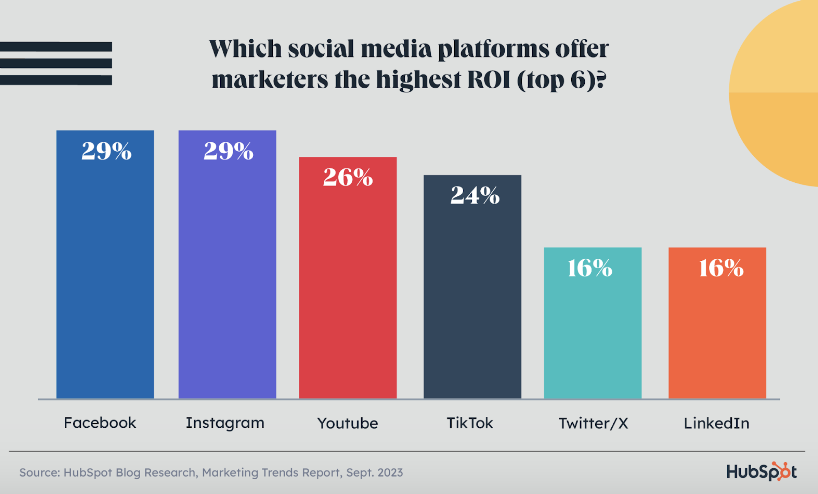
ROI for social media platforms
How to Get Started With Social Media Management?
Social media management might look slightly different for each company, depending on their target audiences and the channels they choose to leverage. However, here are some standard steps to start your social media management journey.
Analyze Your Current Social Media Strategy
Skip this step if it's your first time venturing into social media management.
If you have been using social media for your brand, start by analyzing the current strategy. What are you doing, and where are you doing it?
Start with an inventory of all your social profiles. Don't limit yourself to your "main" channels. Also, count that Pinterest account you created years ago and barely use and the Facebook account with 50 followers.
It's easier to use a tool since you can get all your profiles' analytics and metrics in one place. Talkwalker has a social media audit feature that lets you check everything from audience engagement to posting frequency on your social media channels.

Source: talkwalker.com
You can also check how many of your posts are videos, images, and links. The tool also gives you insights into audience demographics, such as their gender and age.

Talkwalker audience demographics
Know Your Target Audience
Understanding buyers isn't what it used to be. You need to move beyond demographics and start focusing on what your buyers value.
Determine how they feel about the challenges they face and how they expect your solution to deliver when they commit to it.
A great place to start is by creating personas for all types of buyers you have. A well-defined persona will help you establish the most important challenges, needs and desires your buyers have. With this information, you'll be able to produce social media content that appeals to your buyers along their buyer journey.
If you haven't created a persona just yet, try DigitalMarketer's customer avatar template. It includes all you need to get started, along with a helpful explanation of how to build yours.
Customer avatar worksheet
Select Your Social Media Platforms
Choose the social media platforms that best suit your target audience. Some people prefer Instagram for visual content, while others prefer Twitter for short, concise updates. Where your audience is most active will depend on their age and your industry.
For example, research shows that different age groups use different social media platforms. So, brands should keep this trend in mind when choosing the platforms for their social media strategies.
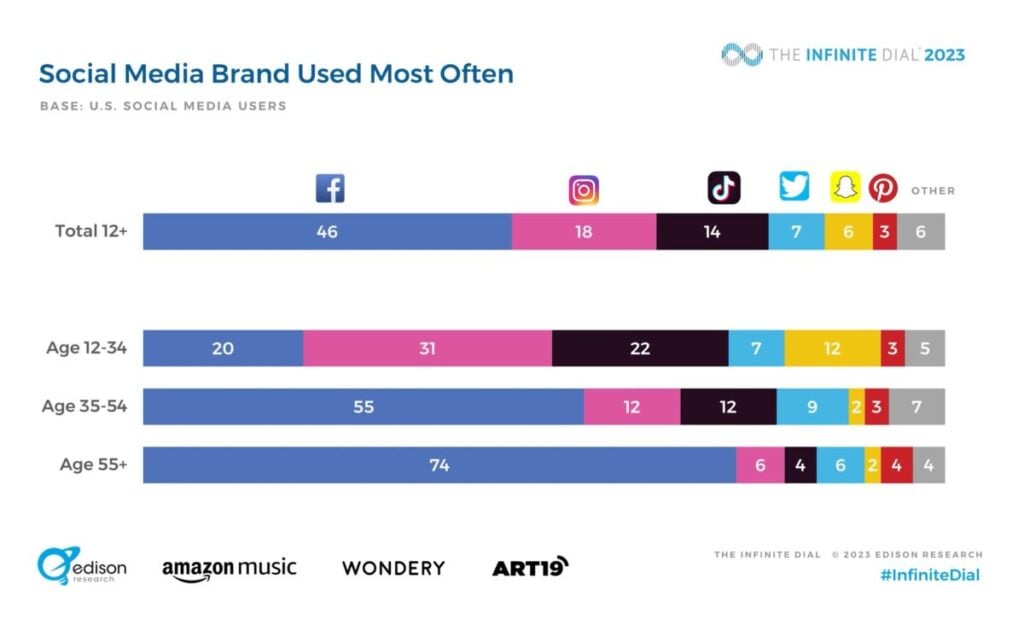
Source: digitalinformationworld.com
If you're a social media marketing manager for an accounting SaaS solution, it's easy to see that TikTok isn't where you should spend time trying to grow your brand.
On the other hand, LinkedIn is a professional social media network. More people turn to it for insights on business, including thought leadership content.
The social media channel you use will also depend on the age of your target audience. Data shows that Gen Z and millennials are more active on social media than their older counterparts.

US social network users by generation
If your target audience falls into the latter age group, you could tap into Connected TV ads or traditional media outlets rather than creating Snapchat filters for them to use.
However, just because an age group is more active on social media doesn't mean it will be on every platform. Statista data shows that even though Gen Z is more active on YouTube, TikTok, and Instagram than the general population, the same trend does not hold for Facebook and LinkedIn.
The easiest way to determine whether your buyers are on a certain social media platform is to use information gathered from your personas and access each platform. Create an account and begin searching for users, hashtags, questions, and content related to your industry.
Some platforms also retain audiences for a longer time, giving you more time to engage with them. For example, people spend 53.8 minutes on average on TikTok, compared to 48.7 on YouTube and 34.1 on X.
Create Your Social Media Strategy
Finally, create your social media strategy. It’s like a map to your social media goals. Here’s what it will dictate:
What Types of Content You'll Produce
The content you'll produce for social media will be informed by who your audience is and what they are interested in.
In 2015, Jeremy Miller wrote a book titled "Sticky Branding." According to Miller, only 3% of your market are active buyers.
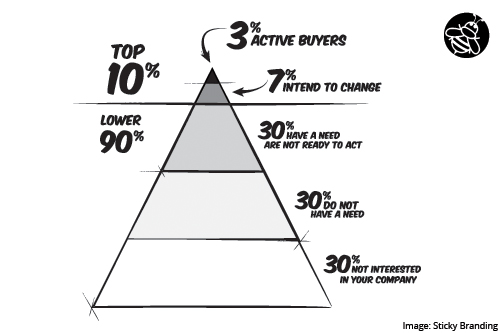
Sticky branding
The remaining pool consists of:
- 7% who may need your product but haven't started searching for options
- 30% who don't have an urgent desire to purchase it right now
- 30% who don't have a need and aren't interested in your marketing
- 30% who aren't the perfect customer because they don't align with your brand
Understanding the above will help you focus on creating content that addresses the states of each buyer.
It also helps to stay on top of the trends. For example, a survey of marketers shows that short-form content tends to give the highest ROI, followed by influencer marketing.
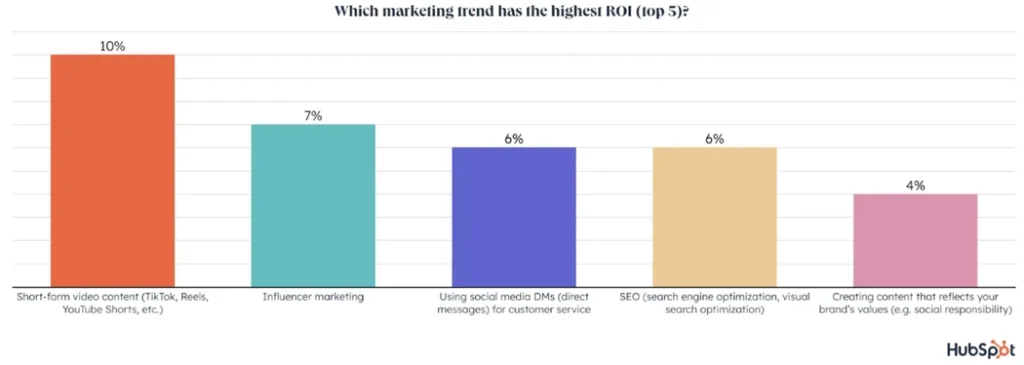
Marketing trend with highest ROI
Similarly, AI-powered content is also becoming popular. While 18% of marketers use AI to get inspiration, 16% use it for repurposing content, 14% for copywriting, and 13% for image generation.
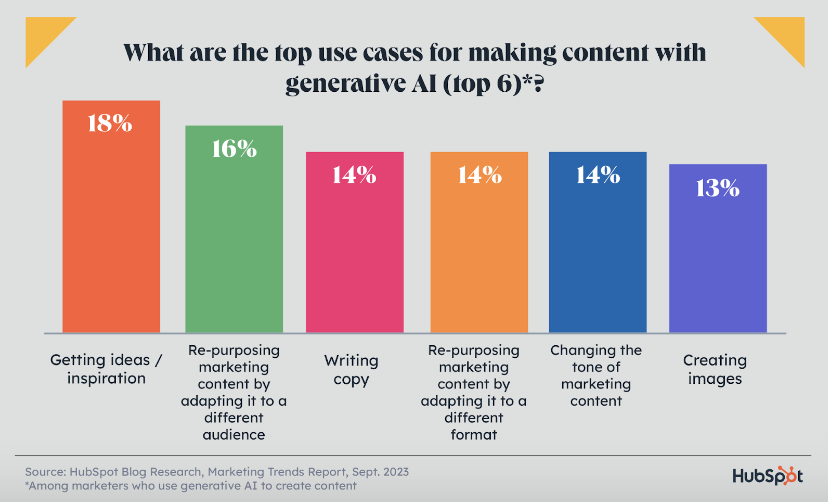
Top use cases for making content with generative AI
Many brands have started using AI in large-scale campaigns, too. For example, Sheep Inc, a fashion brand, used AI-generated images for its campaign.

Sheep Inc AI campaign
So, keep these new, emerging trends in mind while planning what kind of content you'll push out.
How Often You’ll Publish Content and how Much You’ll Create
In a perfect world, you’d be able to create however much content you choose. Budgets, however, dictate how much you can really produce and ultimately share.
You’ll, therefore, need to strike a balance between what your budget allows and what’s most important to share with your customers on social media.
You can use industry benchmarks to decide how often you should post on each social media platform. For example, HubSpot has a helpful table that shows you how often to post on social media. You can increase or decrease it after monitoring your platform analytics dashboard.
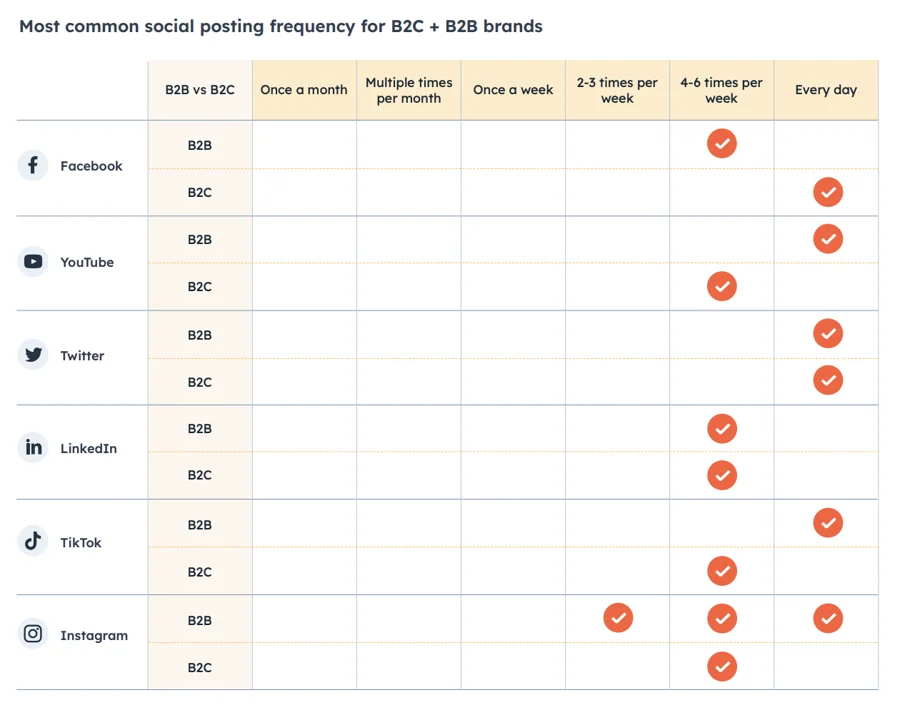
Source: blog.hubspot.com
Besides the platform, you should also determine which type of content you'll produce. Will it be more visual or textual? What will be the length or duration of your content?
Data shows that visual content is ruling the social media space nowadays. In fact, for most brands, anywhere from 20% to over 50% of their content includes visuals.

Visuals in content
Over 52% of marketers use charts and data visualizations most frequently, compared to 46.7% using stock photos and 44.4% using videos and presentations. These industry trends can guide your social media publishing strategy, too.
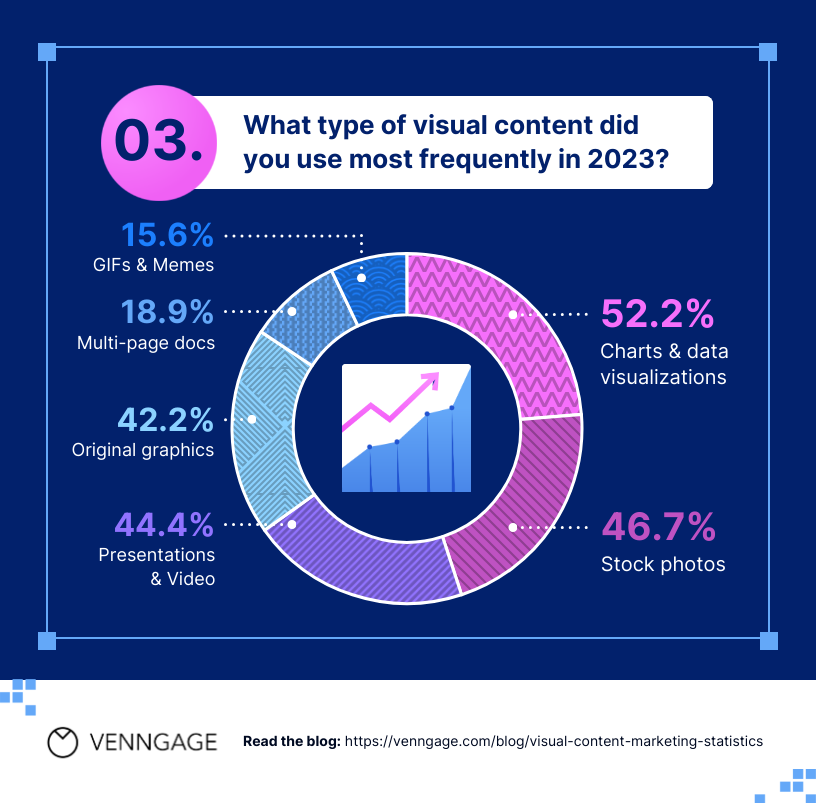
Type of visual content used more frequently
Your content schedule should include all the content that you’ll share on social media. This covers each account, the type of content, and the date and time. For enhanced efficiency, consider incorporating Social Media Schedulers into your content schedule.
You can use a social media management tool like Loomly for its content calendar and other features. It shows all social media content to be published, when it will be published and which social platform account will be used.

Loomly content calendar
What your Customer Engagement Approach Will be
Connecting with your audience isn't just about polls and surveys. It's about answering questions, offering helpful information, and sometimes escalating queries to the right department to resolve.
Your social media strategy will decide how you'll engage with your followers. For example, if you're a SaaS brand, giveaways might be out of the question, but you could always offer a promotion or hold webinars to answer customer questions.
An apparel brand could use UGC for social proof and comment responses to keep followers engaged.
Best Practices for Social Media Management
Ready to upscale your social media management game? These best practices will help.
- Use stories. Sam Balter, Senior Marketing Manager-Podcasts at HubSpot, says,
"Nothing sticks in your head better than a story. Stories can express the most complicated ideas in the most digestible ways."
We agree.
- Provide customer support through social media. Moving forward, brands will find customers slipping into their DMs for real-time support. Be prepared to answer customer questions and resolve their queries. Deborah Eastman, the VP at Cognizant, says that word-of-mouth marketing is
"about delivering an exceptional customer experience that makes customers want to recommend you."
That's not okay! Please DM us with your contact info and the store # or address of the location you ordered from. Thanks! https://t.co/0XgD3py8zp
— Wendy’s (@Wendys) May 16, 2024
- Keep customers at the forefront. Many brands make social media all about themselves rather than their customers. But as David Beebe, a branded content producer, says,
"Content marketing is like a first date. If you only talk about yourself, there won't be a second one."
So, create content that speaks to your customers.
- Analyze, analyze, analyze. Social media is a goldmine of data. Use it to inform social media and other marketing decisions.
Conclusion
Social media management is an important component of both a digital and social media strategy.
While posting content and replying to comments and queries are key elements, structuring your content calendar and consistently publishing content are also crucial. As not all buyers are ready to purchase from your brand immediately, you'll need to nurture them with content that keeps your brand top-of-mind for when they become active buyers.
Use a blend of engaging content, giveaways, relatable posts, influencer marketing, social media ads, and customer support to achieve your social media goals.

